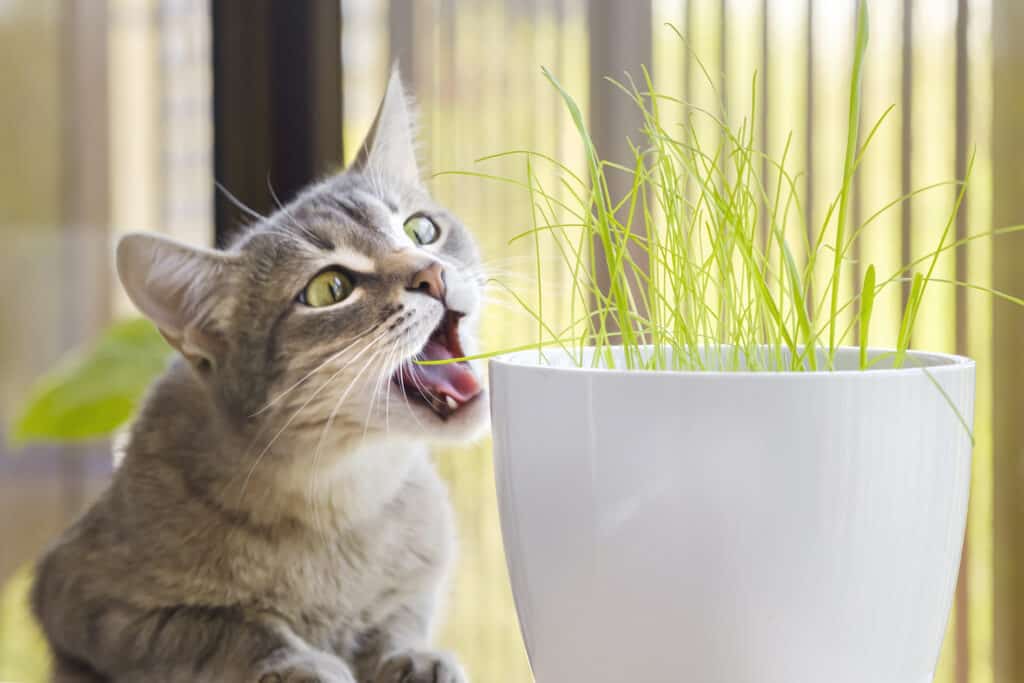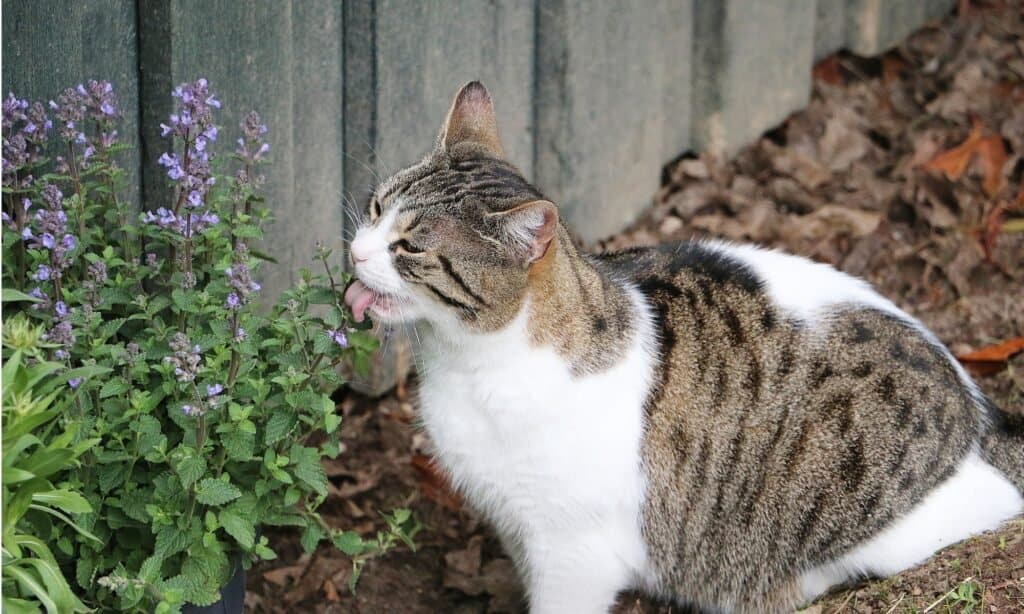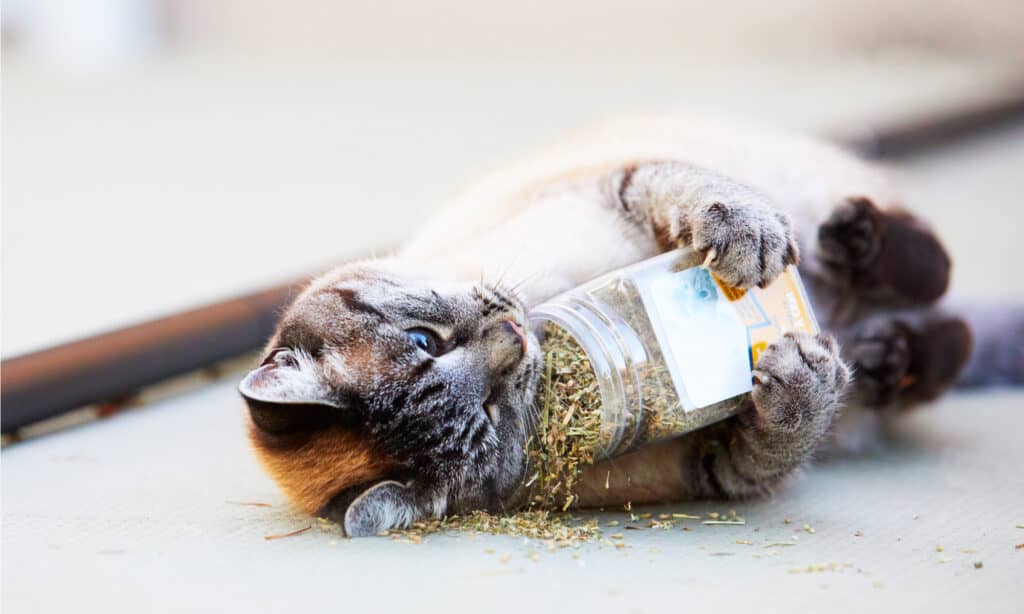If you have a feline friend then you’ve surely heard of catnip — that plant that has a euphoric effect on cats (and in some cases makes them almost high). So, when we hear the word “cat grass” it might be easy to assume that it is simply another name for catnip or even something that has a similar effect on cats. However, cat grass is actually something completely different. But what is it, and what are the differences between the two? Let’s discover everything you need to know about cat grass vs. catnip!
Comparing Catnip vs. Cat Grass

Cat grass is a safe plant for your cat to eat.
©iStock.com/Kseniia Soloveva
Catnip (Nepeta cataria) is a plant within the Lamiaceae family group, which is commonly known as the mint or sage family. Most of the plants in the family are known for being highly aromatic. Catnip is a member of the Nepeta genus of which there are approximately 250 species and several of them —including catnip — are renowned for their effect on cats.
Cat grass is not a specific species of grass. Instead, it is a grass mixture that is grown — usually indoors — specifically for household pets such as cats.
| Catnip | Cat Grass | |
|---|---|---|
| Type of Plant | Herbaceous plant | Specific grass mixture — typically barley, oats, wheat, rye |
| Alternative Names | Catwort, catmint | Pet grass |
| Origin | Asia, China, Middle East, southern and eastern Europe | Commercial |
| Habitat | Woodlands, meadows, pastures, roadsides, wasteland | Grown indoors |
| Size | 2 to 3 feet | 4 inches |
| Leaves | 3 inches, green, heart-shapes, serrated edges, covered with white hairs | Thin stalks |
| Flowers | White, often with purple spots | None |
| Effect on Pets | Euphoric | None |
The 4 Key Differences Between Cat Grass and Catnip
The main difference between cat grass and catnip is that one is an herbaceous plant while the other is a specifically grown grass mixture. The other differences include their size, appearance, and their effect on cats. Catnip is much larger than cat grass and develops small flowers every year. It also has a mind-altering effect on cats while cat grass does not.

Cat eating catnip in the garden. Unlike cat grass, catnip grows lovely flowers in the summer.
©iStock.com/BiancaGrueneberg
Cat Grass vs Catnip: Origin
As we’ve already mentioned, catnip is a specific species — Nepeta cataria — while cat grass is not. Catnip is native to Asia, China, the Middle East, and southern and eastern Europe, although it has also been introduced to many other places. It grows naturally in woodlands, meadows, pastures, wastelands, and even along roadsides.
Cat grass is a specifically grown grass mix that is usually created from oats, wheat, barley, and rye. It is typically grown indoors and has been created and marketed specifically for household pets such as cats.
Cat Grass vs. Catnip: Size
The most noticeable difference between cat grass and catnip is their size. Catnip grows to approximately two to three feet high and the same width. However, cat grass only grows to a height of around four inches.
Cat Grass vs. Catnip: Appearance
Another distinctive difference between these two is what they look like. Cat grass looks visually similar to lawn grass (although it is important to remember that they are not the same). It grows as thin green stalks — usually in small pots.
We’ve already mentioned the size of catnip, but it becomes a mass of stunning green foliage. Its leaves are green and heart-shaped with highly serrated edges, and it develops flowers every summer. The flowers are typically white with small purple spots, which give them a unique appearance. Also, rather than developing fruit, catnip grows small pods that typically have four reddish-brown seeds in them.
Cat Grass vs. Catnip: Effect on Cats

For many cats, catnip can trigger a mind-altering response and euphoria.
©Pixel Cat Photo/Shutterstock.com
The most important difference between cat grass and catnip is their effect on cats. Catnip is well-known for triggering a mind-altering response from approximately 50% of cats. This is because it produces nepetalactone which is a compound that cats react to. Cats detect nepetalactone through their olfactory epithelium which then binds to their olfactory receptors. Most cats react to it by rubbing themselves over the plant and rolling on the ground, as well as licking and chewing it. Quite often they can act like a female in heat. In some cases, cats can become hyperactive and run and jump around. The effects will wear off after a short while — usually around 30 minutes. However, if the cat chews or eats the plant then it can act as a sedative and make them sleepy.
Cat grass doesn’t have any kind of effect on cats. However, it can be useful to them. If you have a cat that likes to chew on your house plants, or you have an outdoor kitty that likes to have a little taste test of your garden plants, then cat grass is a safe alternative as it can prevent them from chewing on something that could be harmful. Chewing on cat grass is also a great way to push out hairballs, or even avoid them in the first place. This is because it works as a laxative and helps to keep cats’ digestive systems working.
Up Next:
- Silver Vine vs Catnip: What Are The Differences?
- The Science Behind Catnip: What It Does To Cats
- Why Do Cats Eat Grass, And What Should You Do About It
The photo featured at the top of this post is ©
Sources
- Excited Cats, Available here: https://excitedcats.com/cat-grass-vs-catnip/
- Ask My Cats, Available here: https://askmycats.com/cat-grass-vs-catnip/
- Archie Cat, Available here: https://archiecat.com/cat-grass-catnip/
- Hills Pet, Available here: https://www.hillspet.com/cat-care/nutrition-feeding/cat-grass-safety-and-information
FAQs (Frequently Asked Questions)
Doesn’t eating grass make cats sick?
You’ve probably heard that eating grass makes cats sick, and your kitty might have even been sick and brought up bits of grass in their vomit. However, cat grass is perfectly safe for your feline friend. As we mentioned earlier, it aids their digestion by acting as a laxative.
Is part of the catnip plant toxic?
No, there are no parts of the catnip plant that are toxic or dangerous to humans or animals.
Is catnip addictive?
No, there is no evidence that catnip it addictive for your cat.
Are catnip and cat grass easy to grow?
Yes, both are very easy to grow and maintain! Catnip is drought-resistant and will grow well in well-drained to fairly dry soil in either full or partial sun. It is very well suited to flower beds or herbaceous borders.
Cat grass is also very simple to grow. For the best results, just scatter your seeds in the soil around 1/4” deep and keep the soil damp but not saturated. The seeds should begin to sprout within seven days of planting.
Why should you give cats catnip?
When cats experience catnip it often encourages them to play. If your cat suffers from obesity then exercise is a great way to tackle it. Playing is also an excellent way for you to bond with your cat. Additionally, catnip can help to alleviate stress and anxiety as well as pain from minor ailments.
Thank you for reading! Have some feedback for us? Contact the AZ Animals editorial team.






